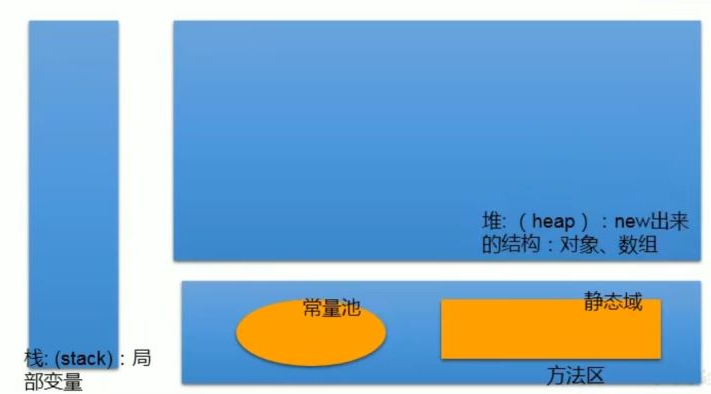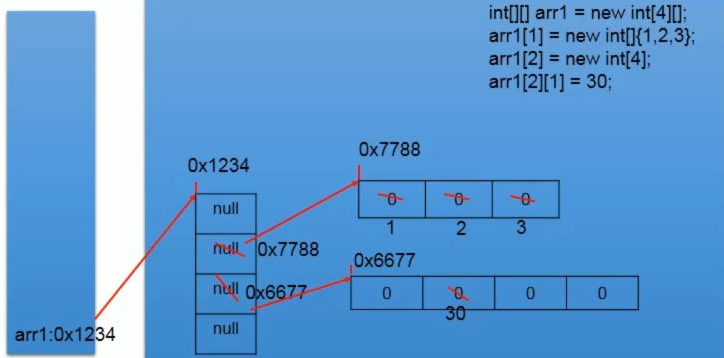array
-
An array is a collection of multiple data of the same type arranged in a certain order, named with a name, and managed uniformly by numbering.
-
Common concepts of arrays
1. Array name
2. Subscript (or index)
3. Elements
4. Length of array: number of elements -
Characteristics of array
Arrays are ordered
The array itself is a reference data type, and the elements in the array can be any data type, including basic data type and reference data type.
Creating an array object will open up a whole contiguous space in memory, and the first address of this contiguous space is referenced in the array name.
Once the length of the array is determined, it cannot be modified.
You can directly call the element at the specified position by subscript (or index), which is very fast.
-
Classification of arrays
1. According to dimension: one-dimensional array, two are arrays
2. According to the type of array element, the array of basic data type elements and the array of reference data type elements -
Default initialization value for array elements
1. Array element is integer: 0
2. Array elements are floating point: 0.0
3. Array elements are char type, 0 or '\ u0000', not '0'
4. Array elements are boolean, false
5. The array element is a reference data type: null
java memory composition

Multidimensional array
- If a one-dimensional array can be regarded as a linear figure in geometry, then a two-dimensional array is equivalent to a table.
- For the understanding of two-dimensional arrays, we can regard them as a pile of arrays array1 and as elements of another one-dimensional array array2. In fact, from the perspective of the underlying operation mechanism of the array, there is no multi-dimensional array.
public class ArrayTest2 { public static void main(String[] args) { //1. Declaration and initialization of two-dimensional array // Static initialization 1 int [][] arr1 = new int[][] {{1,2,3},{4,5},{6,7,8}}; // Static initialization 2 int[] arr4[] = new int[][] {{1,2,3},{4,5},{6,7,8}}; // Static initialization 3 int[] arr5[] = {{1,2,3},{4,5},{6,7,8}}; // Dynamic initialization 1 String[][] arr2 = new String[3][2]; // Dynamic initialization 2 String[][] arr3 = new String[3][]; //2.How to call an element at a specified position of an array System.out.println(arr1[0][1]); //2 System.out.println(arr2[1][1]); //null //System.out.println(arr3[1][0]); //report errors arr3[1] = new String[4]; System.out.println(arr3[1][0]); //null //3.Gets the length of the array System.out.println(arr4.length); //3 System.out.println(arr4[0].length);//3 //4.Traversing a two-dimensional array for(int i = 0; i < arr4.length; i++) { for(int j = 0; j < arr4[i].length; j++) { System.out.print(arr4[i][j] + " "); } System.out.println(); } } }
Two dimensional array
- A two-dimensional array is divided into elements of an outer array and elements of an inner array
For example: int [][] arr = new int[4][3];
Outer elements: arr[0], arr[1], etc
Inner element: arr[0][0], arr[1][2] - Default initialization value for array elements
For initialization method 1: for example, int[][] arr = new int[4][3];
The initialization value of the outer element is: address value
The initialization value of the inner element is: the same as that of the one-dimensional array
For initialization method 2: for example, int[][] arr = new int[4] [];
The initialization value of the outer element is null
The initialization value of the inner element is: it cannot be called, otherwise an error is reported
Two dimensional array memory parsing

public class ArrayTest3 { public static void main(String[] args) { int [][] arr = new int[4][3]; System.out.println(arr[0]); //[I@182decdb <- Unary array address value System.out.println(arr[0][0]); //0 System.out.println(arr); //[[I@7637f22 <- Binary array address value System.out.println("********************************"); float[][] arr1 = new float[4][5]; System.out.println(arr1[0]); //[F@4926097b System.out.println(arr1[0][0]); //0.0 System.out.println("********************************"); String[][] arr2 = new String[4][2]; System.out.println(arr2[1]); //[Ljava.lang.String;@2d363fb3 System.out.println(arr2[1][1]); //null } }